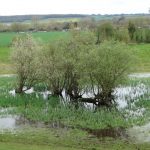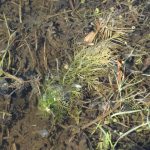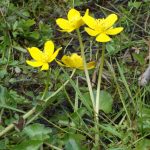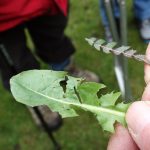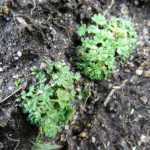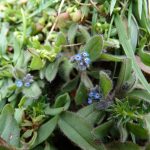Michael Keith-Lucas led a group of 15 members and friends, who braved rain and wind, for a walk on Winter Hill, north of Cookham Dean. Fortunately, the rain soon stopped, the weather improved and later even the sun came out. From the car park there was a nice view of the Thames below and of Marlow north of the river. We took a path going down from the hill and people were surprised that the garden forget-me-not seemed to grow wild here (Wood Forget-me-not, Myosotis sylvatica). Other plants in flower included Cowslips (Primula veris), Ground-ivy (Glechoma hederaceae), Blackthorn (Prunus spinosa) and Lesser Celandine (Ficaria verna). The latter species comprises two subspecies, ssp. fertilis, which produces fruits and fertile seeds, and ssp. verna, which reproduces by means of bulbils formed in the leaf axils and not by seeds. Michael pointed out the leaves of Lords-and-Ladies (Arum maculatum), only half of which were not spotted, although the Latin name of this plant means ‘spotted Arum’, and the Green Alkanet (Pentaglottis sempervirens), which is loved by bees, but not by gardeners, as it seeds itself everywhere and its long black taproots are difficult to remove. Further along we saw Garlic Mustard (Alliaria petiolata), a plant belonging to the Cabbage family but smelling of onions. This is the food plant of the Orange-tip butterfly that lays only one egg on each plant, so that the larvae will have plenty of food. Also along the path both female and male plants of Dog’s Mercury could be seen, distinguished by their flowers and to a certain extent by the leaves, which are slightly larger and more blue-green in female plants. Each plant usually produces many off-shoots, so that a big patch of Dog’s Mercury may be in fact only one plant. Both the Early and Common Dog-violet were in flower (Viola reichenbachiana and V. riviniana), distinguished by the colour of their spur, which is whitish in the Common Dog-violet and purple in the Early one. Michael told us that ‘Dog’ in wild plant names means ‘common’ and not an animal. On a piece of dead wood the Jelly Ear fungus was growing, Auricularia auricular-judae.
Down from the hill, we reached Cock Marsh, an area with ponds, which are relics of old channels of the Thames. These are full of rare water plants such as Frogbit, Water-violet and Brown Galingale, which were not visible yet. However, we did see the leaves appearing of Brooklime (Veronica beccabunga), Yellow Iris (Iris pseudacorus), Hemlock Water-dropwort (Oenanthe crocata), Flowering-rush (Butomus umbellatus), Floating Sweet-grass (Glyceria fluitans) and Rigid Hornwort (Ceratophyllum demersum). Marsh-marigold was already in flower (Caltha palustris). There also was a distinct dandelion microspecies, the Marsh Dandelion, which has very deeply dissected leaves.
We went back up the hill, where Gorse (Ulex europaeus) was in flower on a piece of soil where the chalk will have leached out as it is a species of acid habitats. We followed a steep path, back into the direction of the car park. Along the way, we saw the leaves of many chalk hill species, such as Salad Burnet (Sanguisorba minor) and Hoary Plantain (Plantago media). On ant hills Parsley-piert (Aphanes arvensis), Sticky Mouse-ear (Cerastium glomeratum) and Early Forget-me-not (Myosotis ramosissima) were growing, the latter two in flower. We also found a patch of Meadow Saxifrage (Saxifraga granulata) in bud and an Inkcap fungus (Coprinus spec.). Approaching the car park we saw a Wild Cherry in full flower (Prunus avium) and heard the songs of Chiffchaff (Phylloscopus collybita) and Mistle Thrush (Tardus viscivorus), while Red Kites (Milvus milvus) were flying above us.
Report by Renée Grayer
Pictures by Laurie Haseler

